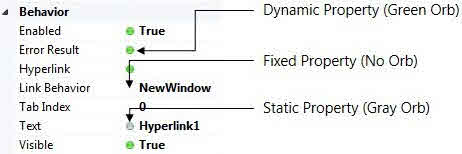MyDriveWorks - Tech Tips
An example of how to make your Form Controls dynamic and responsive to user inputs.
This topic shows how various properties that are static by default can be made dynamic. Making a property dynamic will allow a rule to be built for the property.
The objects within DriveWorks that have static properties include:
Not all properties are static by default. Some properties are fixed, meaning their type cannot be changed at all. Other properties are dynamic by default, these cannot be made static. All properties that are static by default can be made to be dynamic.
A static property is identified by the gray orb that accompanies the property name.

All properties are static by default.
All properties can become dynamic by double clicking the rule icon  next to each property.
next to each property.
Double click the gray radio button  to the right of the property name.
to the right of the property name.
Double click the rule icon  next to the property.
next to the property.
The button will turn green  indicating the property is now dynamic.
indicating the property is now dynamic.
For Specification Macro Task Properties
The data field will turn green 
Please enter a value
will become
="Please enter a value"
(the '=' sign will not be shown when opened in the rule builder)
Numeric and Boolean values will not be enclosed in " ".
Double click the green radio button  to the right of the property name.
to the right of the property name.
Double click the rule icon  next to the property.
next to the property.
The button will turn grey  indicating the property is now static.
indicating the property is now static.
For Specification Macro Task Properties
The data field will turn white 
When returning a changed dynamic property to a static property any rule applied while it was dynamic will be lost.
Form Control Properties will take the result of the existing rule as the static property value.
Specification Tasks (Specification Flow and Macros) will take the previous static property value.
Ensure the property is a dynamic property (It will display the green orb  alongside the property name)
alongside the property name)
 at the end of the property field to launch the rule builder
at the end of the property field to launch the rule builderAn example of how to make your Form Controls dynamic and responsive to user inputs.
View all available MyDriveWorks Tech Tips.
| Knowledge Base Article Ref: | KB13111201 |
|---|